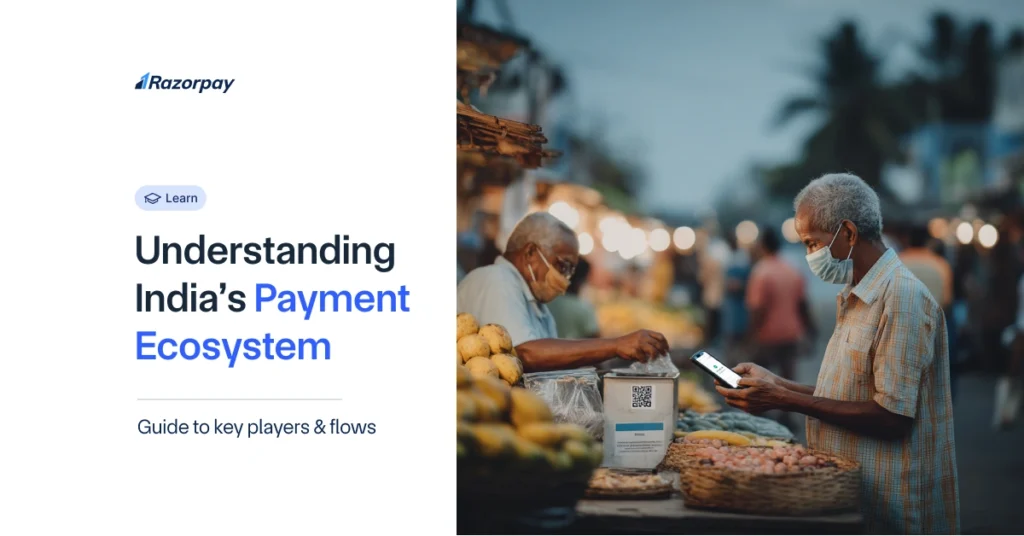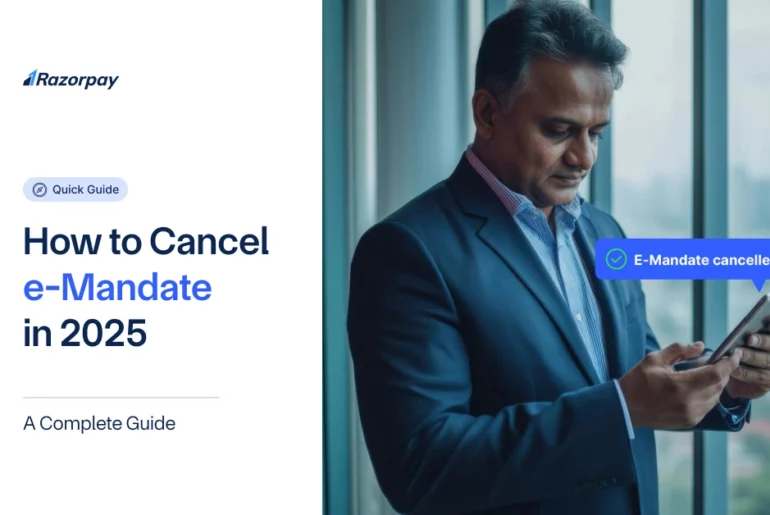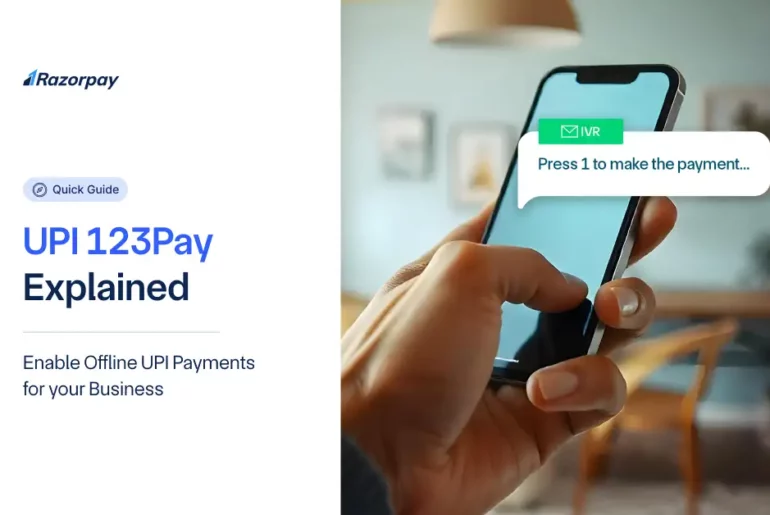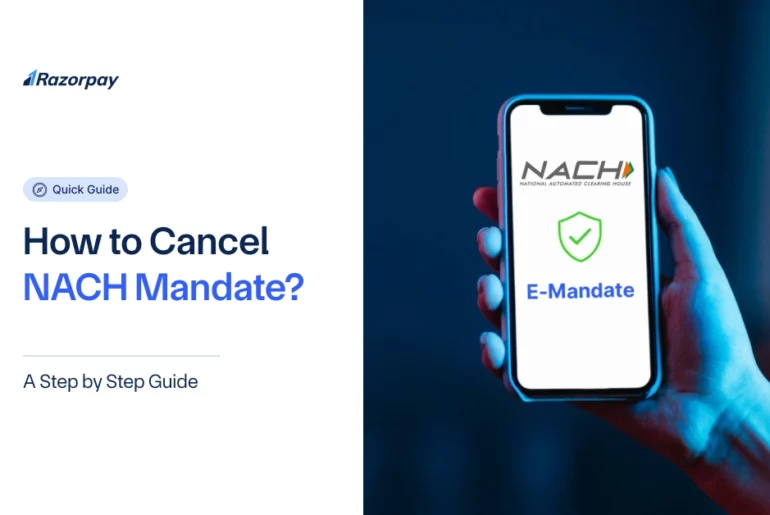India recorded over 18,000 crore digital payment transactions in FY 2024–25 (up to January), as per latest data from the Ministry of Finance. What was once a simple cash exchange has now evolved into a fast-paced digital process that involves multiple systems working together in real time.
Every time a customer pays you a chain of players comes into action. Banks verify account details, payment gateways route the transaction, processors check authorisations, and card networks confirm the transfer. All of this happens within seconds, like a well-coordinated relay where each system must perform its role instantly and pass control to the next without delay.
This frames the payments ecosystem as a dynamic, collaborative network—one where each component must function reliably to support smooth and secure transactions.
As a business owner, you don’t see these systems—but you rely on them every day. That’s why understanding the payments ecosystem is no longer optional.
What Is the Payments Ecosystem?
The payments ecosystem is the digital infrastructure that enables money to move between a buyer and a seller.
It’s the backbone of modern commerce in India—powering everything from a ₹50 UPI payment at a local kirana store to a crore-rupee international export transaction. Whenever you accept or make a payment, this ecosystem quietly ensures that the money flows quickly, securely, and accurately.
To navigate this space effectively, you need to understand the “Payments Language”—a set of commonly used terms that define how the ecosystem functions and who the key players are.
Payments Language: Key Terms You Should Know
- Payment Aggregator (PA): A service provider that collects payments on behalf of multiple merchants and settles them to their respective bank accounts.
- Payment Gateway (PG): A technology provider that securely processes and authorises online payment transactions.
- Acquiring Bank: The bank that holds the merchant’s account and receives the payment on their behalf.
- Issuing Bank: The bank that issued the customer’s debit or credit card or holds their UPI-linked account.
Main Participants in the Payments Ecosystem
1. The Core Participants
Every payment starts and ends with two main people—your customer and you. The consumer initiates the payment, while your role is to provide a secure and convenient payment experience—whether online or offline.
2. The Financial Institutions
- Issuing Bank: This is your customer’s bank. It issues their debit card, credit card, or UPI-linked account and confirms whether funds are available for the transaction.
- Acquiring Bank: This is your bank—the one that enables you to accept digital payments. Once the transaction is approved, the acquiring bank receives the money and settles it into your business account.
3. The Infrastructure
- Payment Networks (Visa, Mastercard, RuPay): These are card networks that route payment authorisation requests between issuing and acquiring banks. They set the rules and facilitate secure communication between banks.
- Switch: When a UPI payment is made, the switch quickly checks where the money is coming from and where it needs to go, then sends the payment request to the right bank in real-time.
4. The Connectors
- Payment Gateway: This is the technology layer that securely transmits card or UPI data from your website or app to the acquiring bank.
- Payment Aggregator: It manages the flow of funds on your behalf. It pools payments from multiple customers and settles them to your account after deducting fees.
5. The Facilitators
- Payment Processors: They handle the backend mechanics—routing data, checking fraud, and settling funds. They work behind the scenes to ensure speed and accuracy.
- Independent Sales Organisations (ISOs): These are third-party firms that help you onboard onto payment systems, often bundling POS machines or e-commerce integration.
- Payment Facilitators (Payfacs): A step ahead of aggregators, Payfacs like Razorpay manage merchant onboarding and compliance, making it easier for small businesses to start accepting payments quickly.
6. The Guardians
- Reserve Bank of India (RBI): As the central regulator, RBI defines licensing norms, cybersecurity rules, and consumer protection measures for all payment service providers.
- National Payments Corporation of India (NPCI): NPCI builds and manages retail payment infrastructure like UPI, RuPay, and IMPS. It also acts as the clearing house for many of these systems.
How a Payment Transaction Works: Step-by-Step
- Initiation: Your customer selects a payment method at checkout—this could be a debit/credit card, UPI, or net banking.
- Authentication: The customer is asked to verify the transaction. For cards, this usually involves entering a one-time password (OTP) sent by the bank. For UPI, the customer enters their UPI PIN on the app.
- Authorisation Request: Once the customer confirms, the payment request travels through a payment gateway to the payment network (e.g., Visa, Mastercard, or NPCI in the case of UPI). The request then reaches the customer’s issuing bank, which checks account balance, fraud risk, and other limits before approving or rejecting the transaction.
- Confirmation Response: The bank’s decision (approved or declined) is sent back through the same path—from the bank to the network, to the gateway, and finally to your system. The customer is shown a success or failure message almost instantly.
- Settlement: Once the transaction is approved, the funds are transferred from the issuer bank to the acquirer bank. From there, the amount is credited to your business account.
Security Challenges and Defenses in India’s Payment Landscape
The Indian payments ecosystem is locked in a constant tug‑of‑war between rapid innovation and evolving threats. As adoption increases, fraudsters find new ways to exploit gaps—forcing regulators, banks and technology providers to deploy ever‑more sophisticated defences.
The Scale of the Challenge
In FY 2023–24, domestic UPI fraud cases jumped by 85%, rising from 7.25 lakh incidents in FY 2022–23 to 13.42 lakh, with losses totalling ₹1,087 crore—an unprecedented spike that underlines the speed and scale of emerging threats.
India’s Regulatory Shield
India’s authorities have responded with layered safeguards:
- Mandatory Additional Factor Authentication (AFA): RBI’s draft framework now requires a second dynamic authentication factor for nearly all digital payments, except small‑value contactless transactions up to ₹5,000 at point-of-sale terminals, recurring payments through e-mandates, and small-value offline digital payments, among others.
- Card Tokenization: Since 2021, RBI directives have prohibited merchants and wallets from storing raw card data, mandating tokenization by 1, October 2022 to minimise exposure of sensitive information.
- DigiSaathi Helpline: NPCI’s 24×7, multi‑lingual helpdesk—launched 8, March 2022—guides users on UPI, IMPS, cards and more, empowering businesses and consumers to resolve queries swiftly.
- PCI DSS v4.0 Compliance: The global standard for cardholder data security—Payment Card Industry Data Security Standard (PCI DSS)—has now fully shifted to version 4.0. As of 31 March 2025, all future-dated requirements have become mandatory, and Indian merchants and banks are expected to be fully compliant.
The Double‑Edged Sword of Generative AI
Generative AI magnifies both sides of the security equation:
- Fraudsters’ Advantage: In May 2024, engineering firm Arup fell victim to a deepfake video call impersonating its CFO, resulting in a $25 million fraudulent transfer—one of the largest known AI‑driven scams to date. Such cases demonstrate how attackers leverage hyper‑realistic voice and video for social‑engineering attacks at scale.
- Defenders’ Arsenal: Regulators and banks are fighting back with AI too. The Reserve Bank Innovation Hub’s MuleHunter.ai platform uses machine learning to detect and block mule accounts—key conduits in laundering proceeds of fraud—showing early success in pilots with two major public sector banks.
Trends Shaping the Payments Landscape
As digital infrastructure matures and customer expectations shift, several key trends are shaping the future of how businesses in India will accept and process payments:
- Contactless & Mobile Payments: More customers now prefer “tap-to-pay” cards and mobile wallets like Google Pay, PhonePe, and Apple Pay. These methods are faster, more convenient, and gaining ground across in-store and online transactions.
- Biometric Authentication: Security is moving beyond OTPs. Fingerprint scans and facial recognition are being integrated into banking and payment apps to offer faster and safer authentication.
- IoT Payments: Devices like smartwatches, voice assistants, and even cars are starting to enable autonomous payments. For example, a smart refrigerator may reorder groceries when supplies run low, or a connected car may enable in-car payments for tolls or fuel.
- Real-Time Cross-Border Payments: As more Indian businesses expand into global markets, the need for faster, low-cost international payments is growing. Payment service providers are now offering solutions that support cross-border transactions while complying with international rules.
Challenges Indian Businesses Face in the Evolving Payments Ecosystem
Accepting digital payments may seem straightforward on the surface, but for many Indian businesses—whether you’re a retailer, freelancer, or exporter—the process can quickly become overwhelming.
Key Challenges for Indian Businesses in the Payments Space
- Selecting the Right Payment Technology: With so many options—UPI, cards, wallets, BNPL, and more—it’s hard to decide which solution works best for your business. You need a system that’s reliable, easy to use, and suits your customers’ payment habits.
- Integrating Payment Systems Securely: Once you choose a solution, adding it to your website, app, or store setup can be tricky. It must work smoothly with your existing tools and protect sensitive customer data from leaks or attacks.
- Keeping Up with RBI Rules and Regulations: Payment rules in India change often. From tokenization to daily limits and authentication requirements, staying compliant is not optional. Failing to meet these standards can lead to penalties or service disruptions.
- Preventing Digital Fraud and Scams: Cybercriminals are now using advanced tools—including AI—to create fake identities, phishing messages, and even deepfakes. Without proper security in place, your business could lose money or customer trust.
- Offering a Smooth Customer Experience: Even with strong security, your payment process must be quick, easy, and error-free. Long wait times, failed transactions, or confusing steps can make customers abandon their purchase.
Razorpay’s Role in Simplifying the Payments Ecosystem
In a payment environment filled with constant change, Razorpay helps Indian businesses cut through the complexity. Whether you’re just starting or scaling up, it acts as both a guide and a shield—making it easier for you to navigate the payments space without hurdles.
Its pre-built infrastructure is fully secure and compliant with PCI DSS and RBI mandates, including tokenisation and two-factor authentication. Its AI-powered fraud detection engine monitors transactions in real time, helping protect your business from scams, chargebacks, and fake transactions before they cause damage.
With support for UPI, cards, net banking, wallets, EMI, and more—all in a single dashboard—Razorpay removes the need for multiple providers. You get a simple, unified system that lets you focus on growing your business, not managing payments.
Conclusion
The payments ecosystem in India is fast-moving and complex, with rising security risks and constantly evolving regulations. But as a business, you don’t have to face this alone.
By partnering with a trusted, secure, and compliant payment aggregator like Razorpay, you can confidently navigate this landscape. It gives you the tools, protection, and flexibility to accept digital payments from anywhere—without the technical or regulatory burden falling on your shoulders.
What could have been a challenge becomes a growth opportunity. With the right support, digital payments aren’t just safer—they become a powerful driver of business expansion.
FAQ
1. What is the difference between a Payment Gateway and a Payment Aggregator?
A payment gateway securely processes transactions. A payment aggregator offers the gateway service plus fraud protection, compliance, and multiple payment options—all in one setup.
2. Why is PCI DSS compliance so important for my business?
It protects customer card data, builds trust, and ensures your business meets global security standards.
3. What is tokenization and how does it protect my customers?
Tokenization replaces sensitive card details with a random, encrypted code (token). This means your systems never store actual card numbers, reducing the risk of data breaches and improving customer trust.
4. How can I protect my business from UPI fraud?
Use secure platforms, enable two-factor authentication, and educate your staff and customers about common fraud tactics.
5. What is a “chargeback” and how do I handle it?
A chargeback is when a customer disputes a payment and asks their bank to reverse it. To handle it, keep clear records, respond quickly to the chargeback notice, and use a payment provider that offers chargeback support.
6. As a small business, what is the easiest way to start accepting digital payments securely?
Use a trusted payment aggregator that offers secure, ready-to-use tools with fraud protection and compliance built in.
7. What are the most popular payment methods in India I should offer?
UPI, debit/credit cards, net banking, and wallets (like Paytm or PhonePe) and EMI options.
References:
- https://www.linkedin.com/pulse/key-players-payment-industry-anurag-mishra-ors6c/
- https://www.finacle.com/insights/blogs/key-trends-shaping-the-global-payments/
- https://www.ey.com/content/dam/ey-unified-site/ey-com/en-in/insights/payments/documents/ey-the-digital-payments-ecosystem-of-india.pdf
- https://www.fortuneindia.com/macro/upi-frauds-63-lakh-cases-worth-485-cr-reported-in-fy25-so-far/119275
- https://timesofindia.indiatimes.com/blogs/voices/from-convenience-to-safety-building-trust-in-the-era-of-digital-frauds/
- https://www.pib.gov.in/PressReleaseIframePage.aspx?PRID=2110405
- https://www.moneycontrol.com/news/opinion/top-challenges-and-opportunities-in-the-digital-payments-ecosystem-in-india-12983460.html




